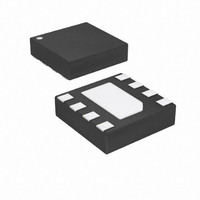ATTINY9-MAHR Atmel, ATTINY9-MAHR Datasheet - Page 19

ATTINY9-MAHR
Manufacturer Part Number
ATTINY9-MAHR
Description
IC MCU AVR 1K FLASH 8UDFN
Manufacturer
Atmel
Series
AVR® ATtinyr
Datasheet
1.ATTINY9-MAHR.pdf
(169 pages)
Specifications of ATTINY9-MAHR
Package / Case
8-UDFN Exposed Pad
Voltage - Supply (vcc/vdd)
1.8 V ~ 5.5 V
Operating Temperature
-40°C ~ 85°C
Speed
12MHz
Number Of I /o
4
Core Processor
AVR
Program Memory Type
FLASH
Ram Size
32 x 8
Program Memory Size
1KB (1K x 8)
Oscillator Type
Internal
Peripherals
POR, PWM, WDT
Core Size
8-Bit
Lead Free Status / RoHS Status
Lead free / RoHS Compliant
Eeprom Size
-
Data Converters
-
Connectivity
-
Lead Free Status / Rohs Status
Details
Available stocks
Company
Part Number
Manufacturer
Quantity
Price
Company:
Part Number:
ATTINY9-MAHR
Manufacturer:
ST
Quantity:
101
- Current page: 19 of 169
- Download datasheet (5Mb)
6.2.3
6.2.4
6.2.5
6.3
6.3.1
8127D–AVR–02/10
System Clock Prescaler
Internal 128 kHz Oscillator
Switching Clock Source
Default Clock Source
Switching Prescaler Setting
The internal 128 kHz oscillator is a low power oscillator providing a clock of 128 kHz. The fre-
quency depends on supply voltage, temperature and batch variations. This clock may be select
as the main clock by setting the CLKMS[1:0] bits in CLKMSR to 0b01.
The main clock source can be switched at run-time using the
Register” on page
that no glitch occurs in the main clock.
The calibrated internal 8 MHz oscillator is always selected as main clock when the device is
powered up or has been reset. The synchronous system clock is the main clock divided by 8,
controlled by the System Clock Prescaler. The Clock Prescaler Select Bits can be written later to
change the system clock frequency. See “System Clock Prescaler”.
The system clock is derived from the main clock via the System Clock Prescaler. The system
clock can be divided by setting the
tem clock prescaler can be used to decrease power consumption at times when requirements
for processing power is low or to bring the system clock within limits of maximum frequency. The
prescaler can be used with all main clock source options, and it will affect the clock frequency of
the CPU and all synchronous peripherals.
The System Clock Prescaler can be used to implement run-time changes of the internal clock
frequency while still ensuring stable operation.
When switching between prescaler settings, the system clock prescaler ensures that no glitch
occurs in the system clock and that no intermediate frequency is higher than neither the clock
frequency corresponding the previous setting, nor the clock frequency corresponding to the new
setting.
The ripple counter that implements the prescaler runs at the frequency of the main clock, which
may be faster than the CPU's clock frequency. Hence, it is not possible to determine the state of
the prescaler - even if it were readable, and the exact time it takes to switch from one clock divi-
sion to another cannot be exactly predicted.
From the time the CLKPS values are written, it takes between T1 + T2 and T1 + 2*T2 before the
new clock frequency is active. In this interval, two active clock edges are produced. Here, T1 is
the previous clock period, and T2 is the period corresponding to the new prescaler setting.
21. When switching between any clock sources, the clock system ensures
“CLKPSR – Clock Prescale Register” on page
“CLKMSR – Clock Main Settings
ATtiny4/5/9/10
22. The sys-
19
Related parts for ATTINY9-MAHR
Image
Part Number
Description
Manufacturer
Datasheet
Request
R

Part Number:
Description:
Manufacturer:
Atmel Corporation
Datasheet:

Part Number:
Description:
IC MCU AVR 1KB FLASH SOT-23-6
Manufacturer:
Atmel
Datasheet:

Part Number:
Description:
IC MCU AVR 1KB FLASH SOT-23-6
Manufacturer:
Atmel
Datasheet:

Part Number:
Description:
IC MCU AVR 1K FLASH 8UDFN
Manufacturer:
Atmel
Datasheet:

Part Number:
Description:
DEV KIT FOR AVR/AVR32
Manufacturer:
Atmel
Datasheet:

Part Number:
Description:
INTERVAL AND WIPE/WASH WIPER CONTROL IC WITH DELAY
Manufacturer:
ATMEL Corporation
Datasheet:

Part Number:
Description:
Low-Voltage Voice-Switched IC for Hands-Free Operation
Manufacturer:
ATMEL Corporation
Datasheet:

Part Number:
Description:
MONOLITHIC INTEGRATED FEATUREPHONE CIRCUIT
Manufacturer:
ATMEL Corporation
Datasheet:

Part Number:
Description:
AM-FM Receiver IC U4255BM-M
Manufacturer:
ATMEL Corporation
Datasheet:

Part Number:
Description:
Monolithic Integrated Feature Phone Circuit
Manufacturer:
ATMEL Corporation
Datasheet:

Part Number:
Description:
Multistandard Video-IF and Quasi Parallel Sound Processing
Manufacturer:
ATMEL Corporation
Datasheet:

Part Number:
Description:
High-performance EE PLD
Manufacturer:
ATMEL Corporation
Datasheet:











